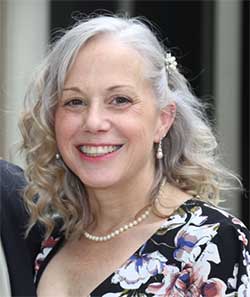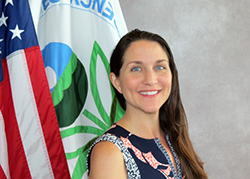Federal Facilities Online Academy: RODs (Records of Decision) and More at Federal Facilities
Sponsored by: US EPA Federal Facilities Restoration and Reuse Office (FFRRO)
Archived: Monday, November 4, 2019
Federal Facilities Online Academy: RODs (Records of Decision) and More at Federal Facilities
2019-11-04
US EPA Federal Facilities Restoration and Reuse Office (FFRRO)
RODs [Records of Decision] and More at Federal Facilities is a two-hour webinar course that will provide an overview of how early and interim actions, adaptive management, RODs, Explanations of Significant Differences (ESDs), and ROD Amendments are used at Federal Facilities. By taking this course, participants will achieve the following objectives:
- Understand how removal actions, sampling and analysis plans, and decision documents are used at Federal Facilities;
- Learn about the Environmental Protection Agency (EPA) and Department of Energy (DoE) Joint Policy Memo;
- Identify how Interim Actions can be used as part of an overall cleanup strategy; and,
- Learn the process for changing remedies after a ROD is issued.
The instructional methodology for this course includes lecture, group discussions, case studies, and quizzes. There will also be an opportunity for participants to ask questions. The target audience for this course is federal, state, and tribal representatives who work on Federal Facility cleanups. Ideally, students should have a basic understanding of the Comprehensive Environmental Response, Compensation, and Liability Act (CERCLA) process. This course is part of the Federal Facilities Academy training program. Please consider registering for other Federal Facility Academy courses and obtain a certificate upon completion of the entire Federal Facility Academy series (12 courses total).
Upcoming Federal Facilities Online Academy Webinars
Accessibility, Recording, and Content Disclaimer
Rehabilitation Act Notice for Reasonable Accommodation
It is EPA's policy to make reasonable accommodation to persons with disabilities wishing to participate in the agency's programs and activities, pursuant to the Rehabilitation Act of 1973, 29 U.S.C. 791. Any request for accommodation should be made to Emerald Laija at 202-564-2724 or Laija.Emerald@epa.gov, preferably one week or more in advance of the webinar, so that EPA will have sufficient time to process the request. EPA would welcome specific recommendations from requestors specifying the nature or type of accommodation needed. Please note that CLU-IN provides both alternate phone call-in options and closed captioning for all webinars, and requests for these specific accommodations are not necessary.
Webinar Recording
By participating in this CLU-IN webinar, you automatically agree to authorize recording of audio and visual content presented during this live event and consent to subsequent use of this recording in the public domain by the U.S. Environmental Protection Agency. This recording may include questions, comments and poll responses provided by you during the live event in addition to your name, voice, image or likeness. This recording will be made available after the conclusion of the live event as part of the CLU-IN webinar archives, and will remain available indefinitely. If you do not wish to consent to the recording, please do not join the live event, and contact Jean Balent at 202-566-0832 or balent.jean@epa.gov to discuss your concerns.
Content Disclaimer
This webinar is intended solely to provide information to the public. The views and opinions expressed as part of this webinar do not necessarily state or reflect those of the U.S. Environmental Protection Agency. It is not intended, nor can it be relied upon, to create any rights enforceable by any party in litigation with the United States, or to endorse the use of products or services provided by specific vendors. With respect to this webinar, neither the United States Government nor any of their employees, makes any warranty, express or implied, including the warranties of merchantability and fitness for a particular purpose, or assumes any legal liability or responsibility for the accuracy, completeness, or usefulness of any information, apparatus, product, or process disclosed, or represents that its use would not infringe privately owned rights.
Presenters:
 Emy Laija, EPA Federal Facilities Restoration and Reuse Office (Laija.emerald@Epa.gov or 202-845-3198)
Emy Laija, EPA Federal Facilities Restoration and Reuse Office (Laija.emerald@Epa.gov or 202-845-3198)
Emy Laija is an Environmental Scientist who works on Superfund cleanups of hazardous waste sites through the EPA Federal Facility Restoration and Reuse Office (FFRRO) in Washington, DC. Her position includes implementing national policy, promoting consistency in cleanups, developing training, and developing relationships with other federal agencies and stakeholders. Before working in FFRRO, Emerald worked as a Remedial Project Manager for 8 years in EPA's Hanford Project Office in Richland, WA and continues to serve as a Hanford subject matter expert. She earned a Master's Degree focused in Environmental Studies from University of Nevada-Las Vegas and a Bachelor's Degree from the University of Texas at El Paso.
 Monica McEaddy, US EPA Federal Facilities Restoration Reuse Office (mceaddy.monica@epa.gov or 202-564-0795)
Monica McEaddy, US EPA Federal Facilities Restoration Reuse Office (mceaddy.monica@epa.gov or 202-564-0795)
Monica McEaddy works as an Environmental Engineer in the Federal Facilities Restoration and Reuse Office (FFRRO) in Washington, DC. Monica has been working in FFRRO since 1998 and is the subject matter expert on Post Construction Completion activities (including five-year reviews)and Department of Energy sites and issues. She has also worked on land disposal restriction regulations and toxic chemicals. She earned a Bachelor of Science in Chemical Engineering and a Masters Degree in Environmental Engineer at Howard University in Washington, DC.
 Mary Cooke, US EPA Federal Facilities Restoration Reuse Office (cooke.maryt@epa.gov or 202-564-0788)
Mary Cooke, US EPA Federal Facilities Restoration Reuse Office (cooke.maryt@epa.gov or 202-564-0788)
Mary Cooke is an Environmental Scientist in EPA's Federal Facilities Restoration and Reuse Office (FFRRO) in the Office of Land and Emergency Management (OLEM). Mary is the FFRRO lead for PFASs, Emerging Contaminants, Consistency and Site Assessment among other duties.
Mary joined the federal government in 1998 as an NPL and BRAC remedial project manager for EPA Region III in Philadelphia. She holds a bachelor's degree in Earth Science with minors in Geography and Marine Science from Pennsylvania State University, and a master's degree in Environmental Pollution Control, also from Penn State.
Moderator:
 Jean Balent, U.S. EPA Technology Innovation and Field Services Division (balent.jean@epa.gov or 202-566-0832)
Jean Balent, U.S. EPA Technology Innovation and Field Services Division (balent.jean@epa.gov or 202-566-0832)
Ms Balent is on the staff of the EPA's Technology Innovation and Field Services Division where she has worked to collect and disseminate hazardous waste remediation and characterization information since 2003. Ms Balent manages the Clean Up Information Network website and actively supports online communication and collaboration resources available to EPA. She formerly worked with the US Army Corps of Engineers Environmental Engineering Division in the Buffalo District. Ms Balent was also a member of the SUNY-Buffalo Groundwater Research Group where she constructed and tested large scale models of groundwater flow. Ms Balent has also conducted research relating to the Great Lakes, environmental remediation, and brownfields re-development. She holds a Bachelor's degree in environmental engineering from SUNY-Buffalo and a Master's degree in Information Technology from AIU.
Webinar Slides and References:
Webinar Slides and References:
Additional Resources:
 Federal Facilities Academy Training Tracker (54KB/XLS)
Federal Facilities Academy Training Tracker (54KB/XLS)- Executive Order No. 12580, (1987), 3 C.F.R., p.193 (EO 12580)
 United States Department of Energy and United States Environmental Protection Agency, (1995). "Policy on Decommissioning Department of Energy Facilities Under CERCLA."
United States Department of Energy and United States Environmental Protection Agency, (1995). "Policy on Decommissioning Department of Energy Facilities Under CERCLA." United States Environmental Protection Agency, (2001). "Requirements for Quality Assurance Project Plans Guidance."
United States Environmental Protection Agency, (2001). "Requirements for Quality Assurance Project Plans Guidance." United States Environmental Protection Agency, OSWER Directive 9272.0-17, (2005). "Implementation of the Uniform Federal Policy for Quality Assurance Project Plans (UFP-QAPP) at Federal Facility Hazardous Waste Sites."
United States Environmental Protection Agency, OSWER Directive 9272.0-17, (2005). "Implementation of the Uniform Federal Policy for Quality Assurance Project Plans (UFP-QAPP) at Federal Facility Hazardous Waste Sites." - United States Environmental Protection Agency, (1994). "Guidance on Accelerating CERCLA Environmental Restoration at Federal Facilities."
- United States Environmental Protection Agency. "Comprehensive Environmental Response, Compensation, and Liability Act (CERCLA) and Federal Facilities." Web.
 United States Environmental Protection Agency, OSWER Directive 9200.1-23P. (1999). A Guide to Preparing Superfund Proposed Plans, Records of Decision, and Other Remedy Selection Decision Documents.
United States Environmental Protection Agency, OSWER Directive 9200.1-23P. (1999). A Guide to Preparing Superfund Proposed Plans, Records of Decision, and Other Remedy Selection Decision Documents. United States Environmental Protection Agency, (2018). "Superfund Task Force Recommendation #3: Broaden the Use of Adaptive Management."
United States Environmental Protection Agency, (2018). "Superfund Task Force Recommendation #3: Broaden the Use of Adaptive Management."- United States Department of Defense and United States Environmental Protection Agency. (2006). "DoD/EPA Joint Guidance on Streamlined Site Closeout and NPL Deletion Process For DoD Facilities."
- United States Environmental Protection Agency. (2001). Close Out Procedures for National Priorities List Sites.
 United States Environmental Protection Agency, OSWER 9355.7-03B-P. (2001). "Comprehensive Five-Year Review Guidance."
United States Environmental Protection Agency, OSWER 9355.7-03B-P. (2001). "Comprehensive Five-Year Review Guidance."- United States Environmental Protection Agency. "Five Year Reviews of Federal Facility Cleanups". Web.
If you have a suggested topic or idea for a future CLU-IN internet seminar, please contact:
Technology Integration and Information Branch
PH: 202-566-0832 | Email: balent.jean@epa.gov
Technology Integration and Information Branch
PH: 202-566-0875 | Email: adam.michael@epa.gov





